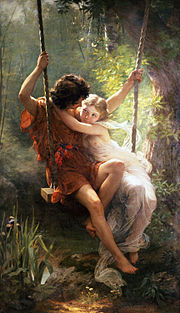Introduction to Psychology 1/IPSY103/Evolutionary psychology/Sexual selection theory
Darwin noticed that there were many traits and behaviors of organisms that could not be explained by “survival selection.” For example, the brilliant plumage of peacocks should actually lower their rates of survival. That is, the peacocks’ feathers act like a neon sign to predators, advertising “Easy, delicious dinner here!” But if these bright feathers only lower peacocks’ chances at survival, why do they have them? The same can be asked of similar characteristics of other animals, such as the large antlers of male stags or the wattles of roosters, which also seem to be unfavorable to survival. Again, if these traits only make the animals less likely to survive, why did they develop in the first place? And how have these animals continued to survive with these traits over thousands and thousands of years? Darwin’s answer to this conundrum was the theory of sexual selection: the evolution of characteristics, not because of survival advantage, but because of mating advantage.
Sexual selection occurs through two processes. The first, intrasexual competition, occurs when members of one sex compete against each other, and the winner gets to mate with a member of the opposite sex. Male stags, for example, battle with their antlers, and the winner (often the stronger one with larger antlers) gains mating access to the female. That is, even though large antlers make it harder for the stags to run through the forest and evade predators (which lowers their survival success), they provide the stags with a better chance of attracting a mate (which increases their reproductive success). Similarly, human males sometimes also compete against each other in physical contests: boxing, wrestling, karate, or group-on-group sports, such as football. Even though engaging in these activities poses a "threat" to their survival success, as with the stag, the victors are often more attractive to potential mates, increasing their reproductive success. Thus, whatever qualities lead to success in intrasexual competition are then passed on with greater frequency due to their association with greater mating success.
The second process of sexual selection is preferential mate choice, also called intersexual selection. In this process, if members of one sex are attracted to certain qualities in mates—such as brilliant plumage, signs of good health, or even intelligence—those desired qualities get passed on in greater numbers, simply because their possessors mate more often. For example, the colorful plumage of peacocks exists due to a long evolutionary history of peahens’ (the term for female peacocks) attraction to males with brilliantly colored feathers.
In all sexually-reproducing species, adaptations in both sexes (males and females) exist due to survival selection and sexual selection. However, unlike other animals where one sex has dominant control over mate choice, humans have “mutual mate choice.” That is, both women and men typically have a say in choosing their mates. And both mates value qualities such as kindness, intelligence, and dependability that are beneficial to long-term relationships—qualities that make good partners and good parents.
